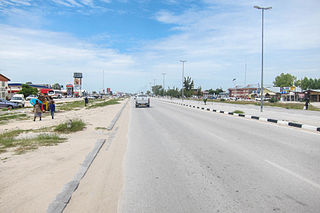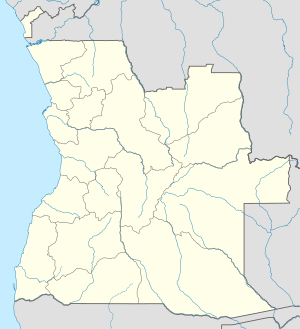
Cunene is a province of Angola. It has an area of 87,342 km2 and a population of 990,087 in 2014.

Ondangwa is a town in the Oshana Region of northern Namibia, bordering the Oshikoto Region. Ondangwa was first established as a mission station of the Finnish Missionary Society in 1890. In 1914, it became a local seat of government.
Ondjiva, formerly Vila Pereira d'Eça, is a town, with a population of 121,537 (2014), and a commune in the municipality of Cuanhama, province of Cunene, Angola. It is also the administrative capital of Cunene Province and is located at the extreme south of the country, about 42 kilometres (26 mi) from the border with Namibia. It was traditionally the seat of the Ovambo king of the Oukwanyama tribe. Ondjiva was greatly affected by the Angolan Civil War (1975-2002).

Xangongo is a town, with a population of 35,000 (2014), and a commune in the municipality of Ombadja, province of Cunene, Angola.
Eenhana is the capital town of the Ohangwena Region, northern Namibia, on the border with Angola. It also used to be a mission station of the Finnish Missionary Society.
Namacunde or Namakunde is a town and municipality in Cunene Province in Angola. The municipality had a population of 142,047 in 2014.
Rupara is a settlement and a former mission station of the Finnish Missionary Society in the Kahenge Constituency in the Kavango West Region in Northern Namibia. It is located 76 km west of Rundu, and 57 km south-east of Nkurenkuru.
Karl Emil Liljeblad was a Finnish pastor, vicar, missionary and educator, and during his final years, a researcher in Folkloristics.

The Finnish Evangelical Lutheran Mission is a Lutheran missionary society formed on January 19, 1859, in Helsinki, Finland. It is one of seven organisations of the Evangelical Lutheran Church of Finland (ELCF) that conduct missionary work. Its first deployments outside Finland were made to Ovamboland, an area that today is cut by the Angola-Namibian border.
Nakayale, also known as Nakayale Keengulu is a village in northern Namibia near Outapi in Omusati Region situated 86km northwest of Oshakati and 4km from Outapi. It is in Anamulenge Constituency.
Omandongo is a populated place in the Onayena Constituency in the Oshikoto Region in northern Namibia, and the region which used to be called Ovamboland.
Engela is an Ovambo settlement in the Ohangwena Region in northern Namibia. Formerly situated in the Oukwanyama area it is since 2004 part of the town Helao Nafidi, although it still maintained its own village council until the 2015 local authority election. It is one of the more important establishments of the Evangelical Lutheran Church in Namibia (ELCIN) in the area. It started as a mission station of the Finnish Missionary Society. Today, it is the centre of the Engela Constituency.
Haufiku Paulus Hamutenya was one of the first seven Ovambos to be ordained a pastor in Oniipa, Ovamboland, in 1925 by the director of the Finnish Missionary Society, Matti Tarkkanen.
Anamulenge is a settlement and former Catholic mission station in the Omusati Region in the north of Namibia in the Ombalantu tribal area. It is the centre of the Anamulenge Constituency.
Omatemba was a mission station of the Rhenish Mission Society in Oukwanyama in southern Angola, located 25 km to the south of Ondjiva.
Oupyakadi was a Roman Catholic mission station in southern Angola, located ca. 50 km to the north of Ondjiva. It was located on the borderland between the tribes of Oukwanyama and Evale.
Matadiva was a short-lived Roman Catholic mission station in southern Angola, located ca. 30 km to the north of Ondjiva. It was located in the northern extremity of the Oukwanyama tribal territory.
Shangalala is a mission station of the Finnish Missionary Society on the Kunene River in Ombadja tribal area in southern Angola, less than 10 km south-west of Xangongo.
Simson Teteinge Haivela Shituwa was one of the first seven Ovambo pastors, whom the director of the Finnish Missionary Society, Matti Tarkkanen ordained into priesthood in Oniipa, Ovamboland, on 27 September 1925, with a permission granted by the Bishop of Tampere, Jaakko Gummerus.
Nangombe Sakeus Iihuhua was one of the first seven Ovambo pastors, whom the director of the Finnish Missionary Society, Matti Tarkkanen ordained into priesthood in Oniipa, Ovamboland, on 27 September 1925, with a permission granted by the Bishop of Tampere, Jaakko Gummerus. His brother Obadja Iihuhua was also ordained at the same time.





